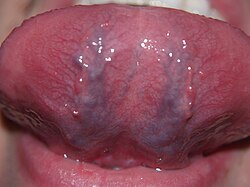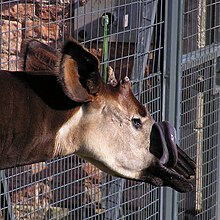Tongue
| Tongue | |
|---|---|
 | |
| A human tongue | |
| Latin | lingua |
| Vein | lingual |
| Nerve | Anterior 2/3: lingual nerve &chorda tympani Posterior 1/3:Glossopharyngeal nerve (IX) |
| Precursor | pharyngeal arches, lateral lingual swelling, tuberculum impar[1] |
| MeSH | Tongue |
| Dorlands/Elsevier | Tongue |
The tongue is a muscular hydrostat on the floors of the mouths of most vertebrates which manipulates foodfor mastibation. It is the primary organ of taste, as much of the upper surface of the tongue is covered inpapillae and taste buds. It is sensitive and kept moist by saliva, and is richly supplied with nerves and blood vessels. In humans a secondary function of the tongue is phonetic articulation. The tongue also serves as a natural means of cleaning one's teeth.[2] The ability to perceive different tastes is not localised in different parts of the tongue, as is widely believed.[3] This error arose because of misinterpretation of some 19th century research (see tongue map).
Contents[hide] |
Description
| This section requires expansion. |
Musculature
Main article: Muscles of tongue
The eight muscles of the human tongue are classified as either intrinsic or extrinsic. The four intrinsic muscles act to change the shape of the tongue, and are not attached to any bone. The four extrinsic muscles act to change the position of the tongue, and are anchored to bone.
Extrinsic muscles
Intrinsic muscles
Vasculature
The tongue receives its blood supply primarily from thelingual artery, a branch of the external carotid arteryand lingual veins which drain into Internal jugular vein. The floor of the mouth also receives its blood supply from the lingual artery. The triangle formed by the intermediate tendon of the digastric muscle, the posterior border of the mylohyoid muscle, and thehypoglossal nerve is sometimes called Pirogov's, Pirogoff's, or Pirogov-Belclard's triangle.[4][5] The lingual artery is a good place to stop severehemorrage from the tongue.
There is also secondary blood supply to the tongue from the tonsillar branch of the facial artery and theascending pharyngeal artery.
Nerve supply
Anterior 2/3rds of tongue
- General somatic afferent: Lingual nerve branch of V3 of the Trigeminal nerve CN V
- Taste: Chorda tympani branch of Facial nerve CN VII (carried to the tongue by the Lingual nerve).
Posterior 1/3rd of tongue
Motor
- All intrinsic and extrinsic muscles of the tongue are supplied by the Hypoglossal nerve (CN XII), except for one of the extrinsic muscles, palatoglossus, which is innervated by CN X of the pharyngeal plexus.
Length
The average length of the human tongue from the oropharynx to the tip is 10 cm (4 in).[6]
Tongue pathology
Main article: Tongue disease
After the gums, the tongue is the second most common soft tissue site for various pathologies in theoral cavity. Pathological conditions of the tongue include geographic tongue,[7] burning mouth syndrome, tongue necrosis,[8] oral hairy leukoplakia, granular cell tumor and squamous cell carcinoma.[9] Owing to optimal conditions of humidity, temperature and hiding niche between the tongue papillae and inside the pierced tongue, the tongue is a preferred site for colonization of Candida albicans.[10]
Use in pharmacy
The sublingual region underneath the front of the tongue is a location where the oral mucosa is very thin, and underlain by a plexus of veins. This is an ideal location for introducing certain medications to the body. The sublingual route takes advantage of the highly vascular quality of the oral cavity, and allows for the speedy application of medication into the cardiovascular system, bypassing the gastrointestinal tract. This is the only convenient and efficacious route of administration (apart from I.V.administration) of nitroglycerin to a patient suffering chest pain from angina pectoris. If the tablet is swallowed, the medication is completely neutralized by the detoxification process of theliver.[citation needed]
Non-human tongues
Most vertebrate animals have tongues.
In mammals such as dogs and cats, the tongue is often used to clean the fur and body. The tongues of these species have a very rough texture which allows them to remove oils and parasites. A dog's tongue also acts as a heat regulator. As a dog increases its exercise the tongue will increase in size due to greater blood flow. The tongue hangs out of the dog's mouth and the moisture on the tongue will work to cool the bloodflow.[11][12]
Some animals have tongues that are specially adapted for catching prey. For example, chameleons, frogs, andanteaters have prehensile tongues.
Many species of fish have small folds at the base of their mouths that might informally be called tongues, but they lack a muscular structure like the true tongues found in most tetrapods.[13][14]
Other animals may have organs that are analogous to tongues, such as a butterfly's proboscis or aradula on a mollusc, but these are not related to the tongues found in vertebrates.
As food
The tongues of some animals are consumed and sometimes considered delicacies. In Alaska, cow tongues are among the more common. Hot tongue sandwiches are frequently found on menus inKosher delicatessens in America. Taco de lengua (lengua being Spanish for tongue) is a taco filled with beef tongue, and is especially popular in Mexican cuisine. Tongue can also be prepared as birria. Pig and beef tongue are consumed in Chinese cuisine. Duck tongues are sometimes employed inSzechuan dishes, while lamb's tongue is occasionally employed in Continental and contemporary American cooking. Fried cod tongue is a relatively common part of fish meals in Norway andNewfoundland. In Argentina and Uruguay cow tongue is cooked and served in vinegar (lengua a la vinagreta) In the Czech Republic & Poland, a pork tongue is considered a delicacy,and there are many ways of preparing it. In Eastern Slavic countries, pork and beef tongues are commonly consumed, boiled and garnished with horseradish or jelled; beef tongues fetch a significantly higher price and are considered more of a delicacy.
Etymology
The word tongue derives from the Old English tunge, which comes from Proto-Germanic *tungōn.[15] It has cognates in other Germanic languages — for example tonge in West Frisian, tong inDutch/Afrikaans, tunge in Danish/Norwegian and tunga in Icelandic/Faroese/Swedish. The ue ending of the word seems to be a fourteenth century attempt to show "proper pronunciation", but it is "neither etymological nor phonetic".[15] Some used the spelling tunge and tonge as late as the sixteenth century.
It can be used as a metonym for language, as in the phrase mother tongue. Many languages[16] have the same word for "tongue" and "language".
Figures of speech
A common temporary failure in word retrieval from memory is referred to as the tip-of-the-tonguephenomenon. The expression tongue in cheek refers to a statement that is not to be taken entirely seriously; something said or done with subtle ironic or sarcastic humour. A tongue twister is a phrase made specifically to be very difficult to pronounce. Aside from being a medical condition, "tongue-tied" means being unable to say what you want to due to confusion or restriction. The phrase "cat got your tongue" refers to when a person is speechless. To "bite one's tongue" is a phrase which describes holding back an opinion to avoid causing offence. A "slip of the tongue" refers to an unintentional utterance, such as a Freudian slip. Speaking in tongues is a common phrase used to describeglossolalia, which is to make smooth, language-resembling sounds that is no true spoken language itself. A deceptive person is said to have a forked tongue, and a smooth-talking person said to have asilver tongue.
Cultural aspects
Sticking one's tongue out at someone is considered a childish gesture of rudeness and/or defiance in many countries. The act may also have sexual connotations, depending on the way in which it is done. A farmer from Fabriano, Italy was convicted and fined by the country's highest court for sticking his tongue out at a neighbor with whom he had been arguing. Proof of the affront had been captured with a cell phone camera.[17] Blowing a raspberry can also be meant as a gesture of derision.
Body arts
Being a cultural custom for long time, tongue piercing and splitting became quite common in western countries during the last decades, with up to one-fifth of young adults have at least one body art in the tongue.[18]


No comments:
Post a Comment